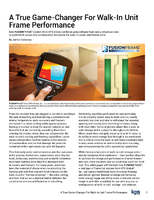Vision and Imaging Sensors / Detectors
Proximity/Light Sensor targets cell phone manufacturers.
Press Release Summary:

Combining functions of digital ambient light sensor with those of digital proximity sensor, Model SFH 7770 determines brightness, detects presence of object nearby, and can tell whether object is moving closer or further away. Sensitivity from 1 µW/cm² to 10 mW/cm² allows unit to operate at distances up to 30 cm. With digital output, sensor supports high-speed I²C bus at up to 3.4 MHz. By returning lux value of 3-65,000, sensor enables display brightness to be adapted to ambient light conditions.
Original Press Release:
New Digital Sensor from OSRAM Combines Proximity and Ambient Light Sensors in One Compact Unit
New freedom of design for cell phone manufacturers
The SFH 7770 from OSRAM Opto Semiconductors combines the functions of a digital ambient light sensor with those of a digital proximity sensor. It determines the ambient brightness, detects the presence of an object nearby and can even tell whether the object is moving closer or moving further away. It means that applications in cell phones and smart phones, for example, can be controlled without touching the phone. Apps open like magic, and the brightness and volume are adjusted at precisely the right moment.
The digital SFH 7770 sensor replaces the usual separate ambient light and proximity sensors and takes up very little space, measuring just 2.8 x 2.8 x 0.9 mm. At the same time, by combining the two functions, it offers added performance and consumes only 350 µA during operation and only 5 µA in stand-by mode.
The proximity sensor uses the reflection of the emitted light from a separate IR LED not only to detect objects close to it but also to recognize whether the object is moving toward or away from it. Its high sensitivity in the range from 1 µW/cm² to 10 mW/cm² allows it to operate at long distances of up to 30 cm. With its digital output, the sensor supports the high-speed I²C bus at up to 3.4 MHz.
When it measures brightness, the integrated ambient light sensor immediately returns a lux value of between 3 and 65,000 lx so that the display brightness can be adapted precisely to the ambient light conditions. This makes the display easier to read and increases the time between battery recharges. The sensor is not influenced by the 50-60 Hz fluctuations in the brightness of ambient light produced, for example, by fluorescent lamps.
The digital double pack of proximity and ambient light sensor gives manufacturers of cell phones new freedom of design. Different functionalities can be achieved with just one component - depending on the phone, it could be only the proximity function, only the ambient light function, or both together. The board design and the number of manufacturing processes are the same in all cases.
The cover design also benefits from the SFH 7770 sensor. "Thanks to the high sensitivity of the SFH 7770, the entire cover can now be made of colored plastic with only minimal loss of range for the sensor," said Dr. Markus Foerste, Head of Development in the Infrared business segment at OSRAM Opto Semiconductors. "There is no longer any need for transparent windows."
By using two further IR LEDs, it is possible to detect gestures with the SFH 7770. The necessary hardware drivers are already integrated. The IR LEDs transmit light signals at a certain frequency. The sensor measures the reflections to detect horizontal and vertical movements. Gesture detection from such small components makes contactless control of applications possible even for very small cell phones and smart phones. Users can flick through photos without even touching the phone or disable an integrated touchpad to prevent starting an app unintentionally.
OSRAM will be presenting the SFH 7770 for the first time at electronica 2010, November 9 -12, in Munich at Booth 107 in hall A3. More information is available at www.osram-os.com/electronica2010.
The SFH 7770 not only adjusts the brightness of cell phone displays to ambient conditions for improved readability and power savings, it also acts as a distance sensor in combination with an IR LED so applications can be controlled without touching the phone.
ABOUT OSRAM OPTO SEMICONDUCTORS
OSRAM is part of the Industry sector of Siemens and one of the two leading lighting manufacturers in the world. Its subsidiary, OSRAM Opto Semiconductors GmbH in Regensburg (Germany), offers its customers solutions based on semiconductor technology for lighting, sensor and visualization applications. OSRAM Opto Semiconductors has production sites in Regensburg (Germany) and Penang (Malaysia). Its headquarters for North America is in Sunnyvale (USA), and for Asia in Hong Kong. OSRAM Opto Semiconductors also has sales offices throughout the world. For more information, go to www.osram-os.com.
PRESS CONTACTS:
Kate Cleveland
OSRAM Opto Semiconductors
(248) 277-8018
kate.cleveland@osram-os.com




